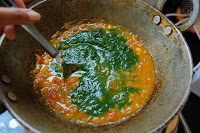Hello All! It's been too long since my last post, but I've been rather busy of late. Nevertheless, I take this time and opportunity to share a fun little recipe with you - an eggless cheesecake that I made for Pranav's birthday last weekend. You don't need too much, and it wont take you more than an hour to finish the job. Here we go!
Eggless Cheesecake (serves 6-8)
- 16 arrowroot buscuits
- 1/4 cup of milk
- 1/3 melted butter
- a dash of cinnamon
- 8 ounces of softened cream cheese
- 1/3 cup of sugar
- 3/4 cup of sour cream
- 8 ounces of whipped cream
Start by taking out the day's frustrations and mash the arrowroot biscuits to pieces. Put the crumbs in a bowl and soften them with the milk and butter. Add the cinnamon for an unexpected hint of spice in the crust. The biscuits will take on a doughy texture - they should be soft, but not too mushy. Press the doughy crust into a 9-inch dish and bake it in the oven at 350 degrees for 6 minutes. Next, combine the remaining items in a large bowl, and keep beating, stirring and mixing until the filling is silky smooth. When the crust is cool, pour in the filling and put your cake into the fridge to chill. A no-bake cheesecake requires at least 10 hours to set, so I recommend doing this at night and sleeping through the temptation to stick your pinky in for a sample. Your cake will be ready to enjoy the next day. If you like toppings on your cheesecake, here's the recipe for a quick glaze.
Strawberry Glaze Topping (to cover the cheesecake)
- 2 cups of fresh strawberries - chopped
- 1 tablespoon cornstarch
- 2 teaspoons lime juice
- 1/8 cup water
- 1/4 cup sugar
Keep the strawberries separate while you mix the cornstarch, lime juice and water in a bowl. The cornstarch will completely dissolve, and you should now add this mixture to the strawberries in a saucepan to cook on medium-low heat. When it thickens and becomes translucent, add the sugar. Keep tasting until you're satisfied with the sweetness. For a more tart glaze, don't add all the sugar. Pour this topping over the cheesecake when it cools, or serve it on the side. Bon Apetit!












